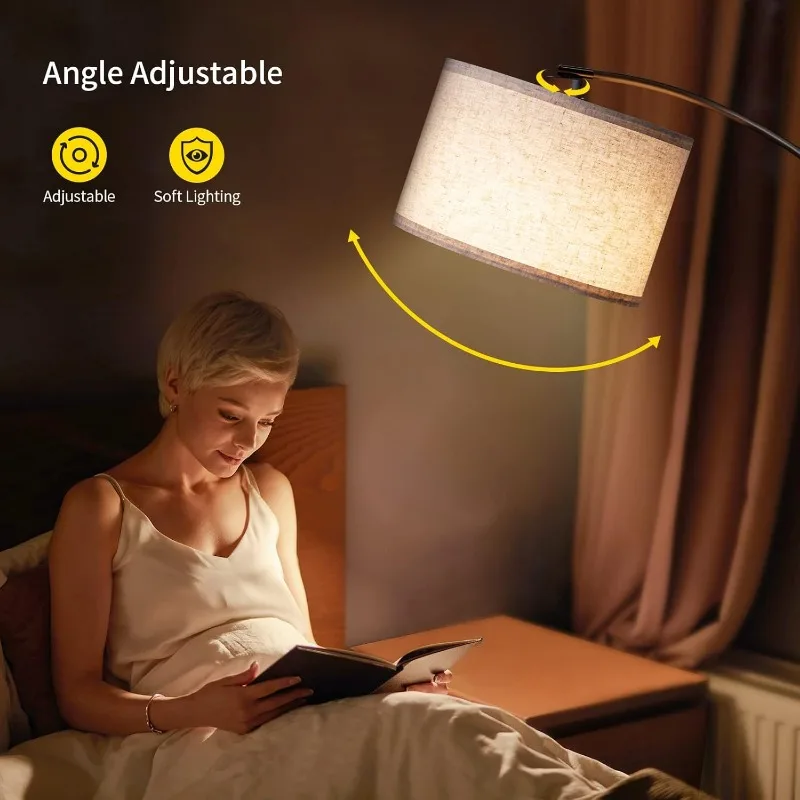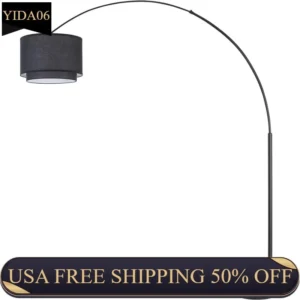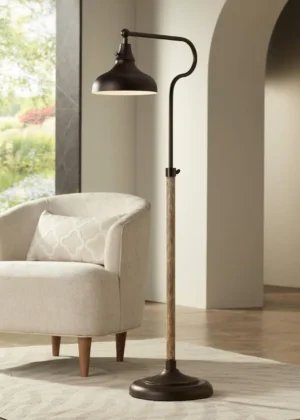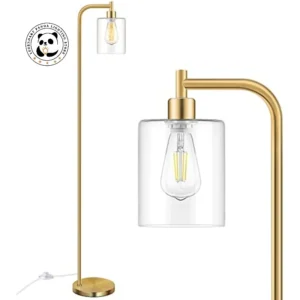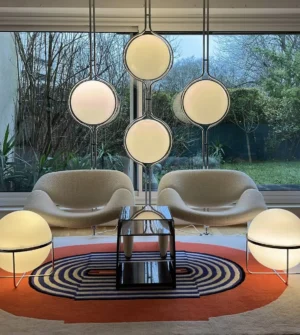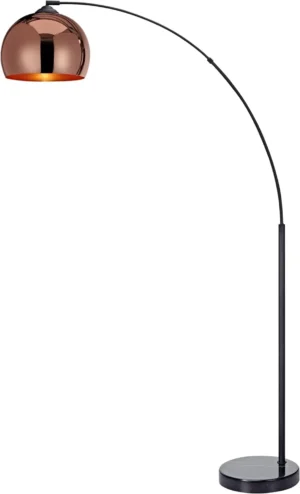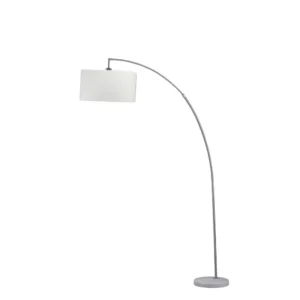Understanding the Challenge of Arc Lamp Wiring
Arc floor lamps are striking pieces of lighting design that add both drama and functionality to any interior. With their sweeping curved arms extending from 5-7 feet tall and cords typically spanning 6-8 feet, these statement pieces create a unique challenge when it comes to wire management. Unlike traditional floor lamps that stand upright near walls, arc lamps curve outward over furniture, meaning their cords often need to travel across more exposed floor space to reach outlets.
The primary challenges of arc lamp wiring include:
- The distance between the lamp base and available power outlets
- Visible cords crossing open floor areas creating visual clutter
- Potential tripping hazards in high-traffic areas
- Cord damage from foot traffic or furniture movement
- Maintaining the lamp’s elegant aesthetic despite necessary wiring
When investing in a beautiful arc lamp, the last thing you want is for dangling or stretched cords to diminish its visual impact. Interior design principles emphasize clean lines and visual flow, with unsightly wires creating jarring interruptions to otherwise thoughtfully designed spaces. Choosing the perfect arc floor lamp requires equal consideration of both the lamp itself and how its wiring will integrate with your space.
Proper wire management not only improves aesthetics but also extends lamp longevity by preventing cord damage from foot traffic, vacuum cleaners, or furniture movement. Let’s explore solutions that preserve both the beauty of your arc lamp and the safety of your home.
Essential Safety Considerations for Wire Management
Before implementing any wire concealment solution, safety must remain the top priority. Follow these essential guidelines to ensure electrical safety while managing your arc lamp cords:
Inspect cord integrity: Examine the full length of your arc lamp cord for any signs of fraying, cracks, or damage before concealing it. Never cover damaged cords.
Avoid compression or pinching: Ensure your cord management solution doesn’t tightly bend, compress, or pinch the electrical cord, which can damage insulation and create fire hazards.
Maintain proper ventilation: Some arc lamp cords may warm during operation, particularly with higher-wattage bulbs. Ensure your concealment method allows for adequate airflow.
Prevent overloading: Check that any extension cords or power strips used with your arc lamp are rated appropriately for the electrical load and avoid daisy-chaining multiple extension cords.
Secure loose cords: Properly secure any excess cord length to prevent tripping hazards, particularly in walkways or high-traffic areas.
Consider professional help: For permanent solutions like in-wall wiring, always consult a licensed electrician to ensure code compliance and safety.
The way you position your arc lamp can significantly affect both safety and aesthetics. Understanding techniques for preventing arc lamps from tipping is an important companion to proper wire management, as proper stability ensures cords won’t be pulled unexpectedly.
When using LED bulbs in your arc lamp, heat output is generally lower than with incandescent options, but you should still avoid completely enclosing cord connections. Always prioritize safety over complete concealment.
Cable Management Channels & Raceways
Cable management channels and raceways provide one of the most effective and professional-looking solutions for discreet arc lamp wiring. These hollow structures create a pathway to contain and conceal cords along walls, baseboards, or floors.
Types of Cable Channels
Self-Adhesive Channels
These feature a peel-and-stick backing for easy installation without tools or wall damage. Ideal for renters or temporary setups, they typically hold 1-2 standard lamp cords and can be removed without damaging most wall surfaces.
Paintable Raceways
Made from PVC or similar materials, these channels can be painted to match your wall color for near-invisible integration with your décor. Available in various sizes, they’re perfect for a more permanent installation while maintaining the option for future changes.
Decorative Channels
These are designed to be visible yet attractive, featuring wood-like finishes, metallic looks, or other decorative elements that complement your interior design rather than disappear into it.
Most channel systems include various connectors and corner pieces that allow you to navigate room corners, doorways, or ceiling transitions with a continuous, polished look. The complete arc floor lamp guide provides additional context on how these wiring solutions integrate with different lamp styles.
| Channel Type | Width | Height | Material | Best For |
|---|---|---|---|---|
| Mini Raceway | 0.5” | 0.5” | PVC | Single lamp cord |
| Standard Channel | 1.25” | 0.5” | Plastic/PVC | 2-3 cords |
| Large Channel | 2” | 0.75” | Aluminum/PVC | Multiple cords/power strips |
| Floor Channel | 3” | 0.25” | Rubber/PVC | Floor crossing areas |
Installation typically requires only basic tools (scissors or a utility knife to cut channels to length), and many systems are designed for tool-free assembly. For the best aesthetic result, measure and plan your cord path carefully before installing.
These channels work particularly well with our adjustable arc floor lamp collection, as they can accommodate the repositioning flexibility these lamps offer without requiring rewiring.
Ultra-Flat Extension Cords & Specialty Plugs
When standard round extension cords create unsightly bumps under rugs or alongside furniture, ultra-flat extension cords offer an elegant alternative for powering your arc lamps. These specialized cords feature a thin, ribbon-like profile measuring approximately 1/8 inch (3mm) thick—up to 75% thinner than conventional round cords.
Benefits of Ultra-Flat Extension Cords:
- Furniture-friendly placement: Cords can run under furniture legs or edges without creating wobble
- Under-rug routing: Can be placed under area rugs without creating noticeable bumps or trip hazards (though only thin rugs are recommended for safety)
- Visual discretion: Lower profile means less visual disruption when crossing open areas
- Specialty plugs: Many include rotating or flat-against-wall plug heads that sit flush against outlets
When selecting flat extension cords for arc lamps, pay attention to electrical ratings. Most arc lamps require 14-16 gauge cords capable of handling up to 10-15 amps, particularly for models with multiple bulbs. Always choose UL-listed products that meet safety standards.
Available in lengths ranging from 3 to 15 feet, these cords can be selected to minimize excess wire. Some models feature transparent or white casing that blends with light-colored flooring, while others come in black or brown to match darker interiors or baseboards.
For the perfect pairing with contemporary lighting, explore our modern arc floor lamps, which feature sleek designs that complement these minimalist wiring solutions.
When routing flat cords, maintain gentle curves rather than sharp bends to prevent internal wire damage and keep at least 12 inches of space between the cord and heat-generating appliances.
Cord Clips, Guides, and Mounting Hardware
Strategic placement of cord clips and guides creates an organized pathway for arc lamp cords, keeping them secure against baseboards, under furniture edges, or along architectural features. These small but mighty accessories prevent cords from sprawling across floors while maintaining a clean aesthetic.
Types of Cord Management Clips:
Adhesive Clips
– Self-adhesive backing requires no tools for installation
– Available in clear, white, black, or paintable versions to match décor
– Typically holds 1-2 lamp cords securely
– Best for smooth surfaces like painted walls, wood, or plastic
Nail-In or Screw Guides
– More permanent and stronger holding capacity
– Ideal for baseboards, wooden furniture, or areas where adhesive might fail
– Provides secure anchoring for heavier cords or high-traffic areas
– Requires basic tools but offers greater longevity
Magnetic Cord Guides
– Perfect for metal furniture, filing cabinets, or metal lamp bases
– No adhesive or hardware required
– Easily repositionable when needed
– Limited to use with metal surfaces
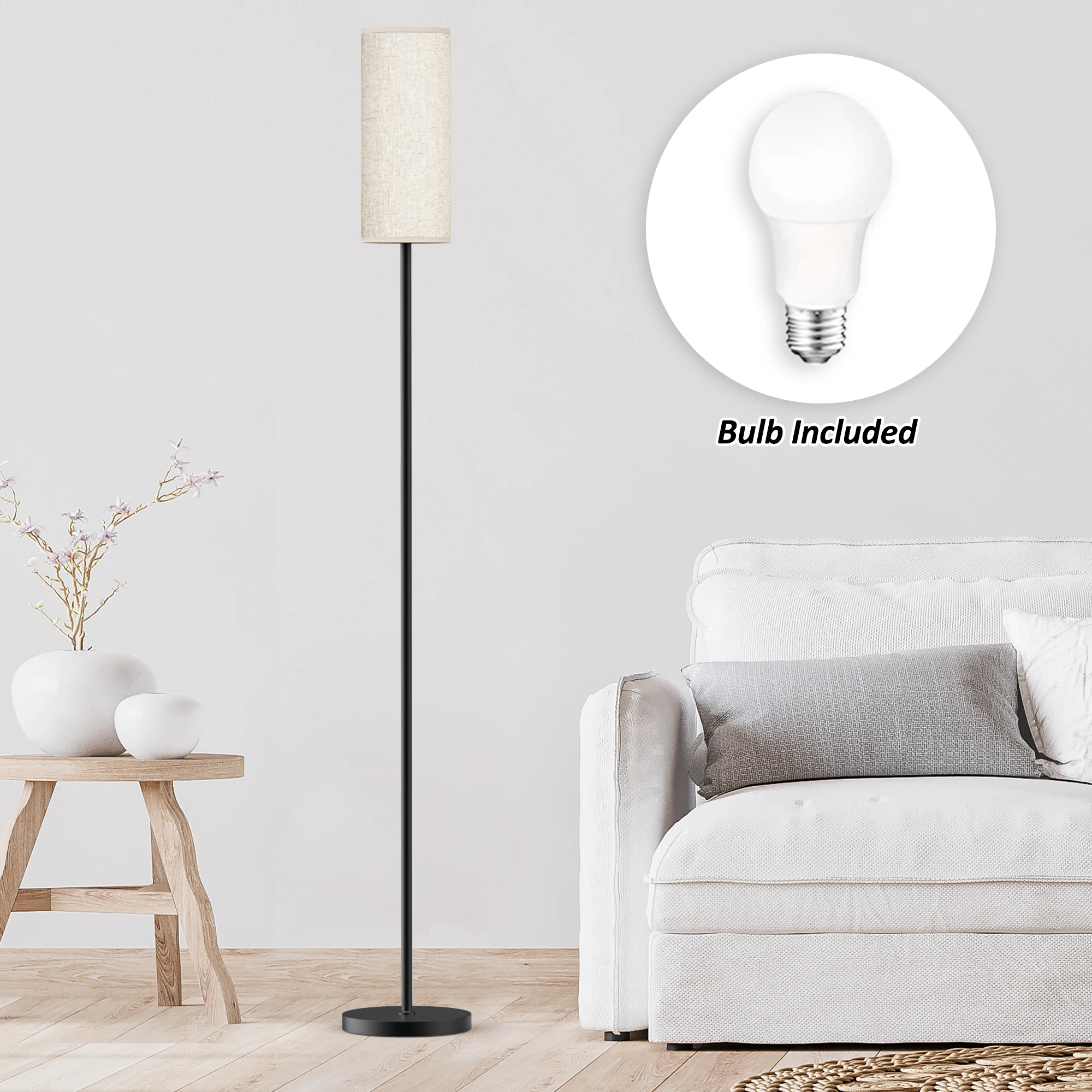
For optimal cord management, place clips every 12-18 inches along your desired cord path. When routing around corners, use additional clips to maintain gentle curves rather than sharp bends that could damage the internal wires.
Consider using different clip styles in combination—adhesive clips for walls and vertical surfaces, with nail-in guides for baseboards, and magnetic options for metal furniture. This creates a comprehensive system that addresses various surfaces throughout your cord’s path.
When selecting adhesive clips, look for those with 3M or similar quality adhesive that won’t damage surfaces upon removal. For rental properties, removable adhesive options allow for damage-free installation and future adjustments.
Color-matching your clips to your cord color or surrounding surfaces makes them virtually disappear. Some homeowners even paint their clip sets to perfectly match unique wall colors or wood tones.
Decorative Cord Covers and Sleeves
Rather than hiding cords completely, decorative cord covers transform your arc lamp’s wiring into a design feature. This approach acknowledges the cord’s presence while elevating its appearance to complement your décor.
Stylish Cord Cover Options:
Fabric Sleeves
– Available in various textures including cotton, linen, nylon mesh, and natural jute
– Easily slides over existing cords without rewiring
– Washable options available for high-traffic areas
– Adds textile interest to industrial elements
Decorative Wraps
– Includes options like leather wrapping, colorful paracord, or metallic spiral wrapping
– Creates visual interest through texture and color
– Can coordinate with furniture or other room accessories
– Offers protection against minor cord abrasion
Beaded or Embellished Covers
– Features decorative elements like wooden beads or metallic accents
– Makes cord a deliberate design statement
– Works particularly well with bohemian, eclectic, or artistic interiors
– Often handcrafted and customizable
When selecting decorative covers, consider both the diameter of your lamp cord (typically 3/8” to 1/2”) and the desired finished look. Many covers expand to slip over the plug end, then compress to fit snugly around the cord itself.
For a cohesive look, choose covers that complement other elements in your room, such as throw pillow fabrics, curtain materials, or furniture finishes. Our perfect arc floor lamp guide offers additional tips on coordinating these elements for a harmonious interior.
Maintenance varies by material—fabric sleeves may require occasional cleaning, while leather or synthetic covers can typically be wiped clean. When selecting cord covers for high-traffic areas, opt for durable, washable materials that can withstand foot traffic or vacuum contact.
For a striking contrast, consider pairing decorative cord covers with our black arc floor lamp collection, where the textured cord creates an interesting visual counterpoint to the sleek lamp finish.
Strategic Placement Techniques for Minimal Visibility
Sometimes the best cord management solution involves no additional products—just strategic furniture arrangement and thoughtful lamp placement. These techniques can dramatically reduce cord visibility while maintaining both functionality and design integrity.
Room Layout Strategies:
Furniture Blocking
– Position sofas, consoles, or bookcases to create natural cord pathways behind them
– Use furniture with “floating” legs to allow cords to pass underneath while remaining hidden from view
– Place area rugs strategically to cover cord paths between furniture pieces
– Consider furniture with built-in cord management features like hollow legs or back panels
Wall-Hugging Techniques
– Route cords along wall edges and baseboards where they’re least noticeable
– Use architectural features like crown molding, chair rails, or door frames to disguise cord paths
– Position the arc lamp base within 1-2 feet of walls when possible
– Plan pathways that follow natural room divisions or transitions
Strategic Outlet Usage
– Choose the power outlet closest to your intended lamp position
– Consider floor outlets for centrally positioned arc lamps
– Map the shortest possible cord path from lamp to outlet
– When renovating, install additional outlets in optimal locations for future lighting
The way you position your arc lamp can significantly impact both its visual appeal and wiring challenges. Understanding the ergonomic benefits of adjustable arc lamps helps you determine optimal placement for both function and aesthetics.
For open floor plans, consider using room dividers, large plants, or decorative screens to create cord concealment opportunities while defining separate functional areas. Bookcase room dividers are particularly effective as they provide both cord hiding surfaces and natural pathways.
Remember that cord visibility matters most from primary viewing angles—focus your concealment efforts on the perspectives from seating areas and entryways rather than trying to hide cords from every possible angle.
Cord Management Boxes and Power Strip Concealers
When multiple devices cluster near a single outlet or when excess cord length creates clutter, cord management boxes and power strip concealers provide elegant solutions. These decorative containers hide power strips, adapters, and extra cord length while maintaining accessibility and proper ventilation.
Types of Cord Management Containers:
Cable Management Boxes
– Conceal power strips and excess cords in stylish containers
– Available in various materials including wood, plastic, and metal
– Feature rear openings for cord entry/exit while containing the bulk inside
– Range from simple boxes to furniture-quality decorative pieces
Under-Desk Cord Organizers
– Mount to the underside of tables or desks to keep cords off the floor
– Particularly useful for arc lamps positioned near work areas
– Available in trays, baskets, or raceway styles
– Reduce cord tangles and floor clutter simultaneously
Decorative Baskets and Containers
– Repurpose attractive storage pieces for cord management
– Natural materials like seagrass, water hyacinth, or wood blend with décor
– Allow for larger storage capacity than purpose-made boxes
– Can be positioned strategically beside furniture
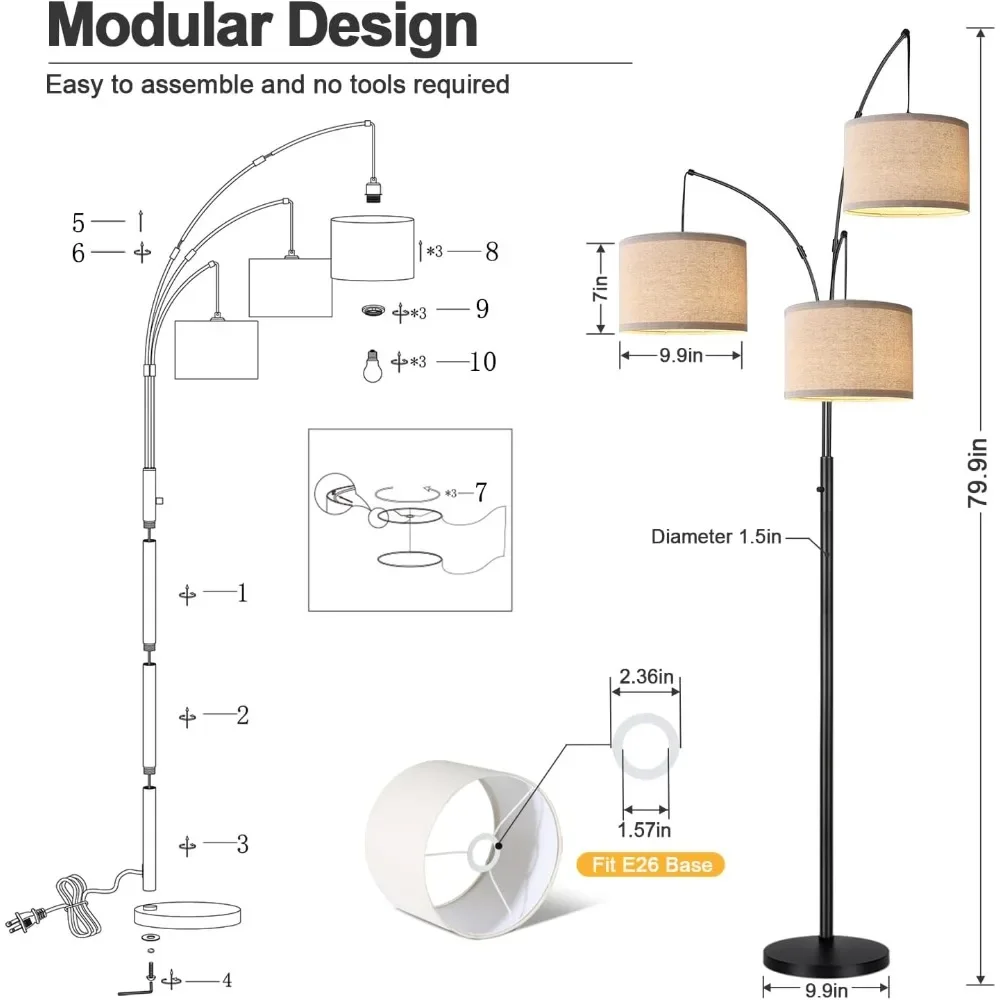
When selecting a cord management box, ensure it provides adequate ventilation to prevent overheating of power adapters or transformers. Many quality options feature slotted sides or bottoms to promote airflow while maintaining a clean appearance.
Size considerations are important—measure your power strip and adapter collection before purchasing a management box. Typical dimensions range from 12”×5”×5” for standard power strips to larger 16”×6”×6” options for more comprehensive setups.
These solutions work particularly well with our dimmable arc floor lamp collection, where dimmer controls and transformers can be neatly contained while maintaining easy access for adjustment.
For the most cohesive look, choose cord management boxes that complement your existing furniture finishes—warm wood tones, matte black, or white are versatile options that blend with most décor styles.
Advanced Solutions: In-Wall Cord Management
For the ultimate in discreet arc lamp wiring, in-wall solutions create completely invisible power access. While these approaches require more effort and expertise, they deliver the cleanest possible aesthetic result with no visible cords whatsoever.
In-Wall Management Options:
In-Wall Power Kits
– Create recessed outlets exactly where needed for arc lamps
– Include everything needed for installation in standard drywall
– Require basic DIY skills and simple tools
– Typically include both input and output outlet boxes connected by an in-wall power channel
Surface-Mount Power Bridges
– Less invasive alternative to in-wall solutions
– Create a flat channel along the wall surface that can be painted
– Connect to existing outlets while creating new access points
– Easier installation than true in-wall systems
Code-Compliant Considerations
– In-wall installations must use UL-listed components
– Standard lamp cords should never be run inside walls
– Power must run through approved in-wall cables
– Some jurisdictions require electrical permits or professional installation
When considering in-wall solutions, understand that this approach is most suitable for homeowners rather than renters. Professional installation typically costs $150-$300 per connection point, while DIY kits range from $50-$100 for basic setups.
For rentals or situations where wall modifications aren’t possible, surface-mount power bridges offer a compromise—less invasive than true in-wall solutions while providing cleaner results than exposed cords.
The installation process typically takes 1-2 hours for those with basic DIY skills and requires tools like drywall saws, stud finders, and screwdrivers. The most important consideration is ensuring you don’t cut into existing wiring, plumbing, or structural elements in your walls.
DIY Hacks for Arc Lamp Cord Concealment
For budget-friendly alternatives to commercial products, these creative DIY approaches use common household items to conceal arc lamp cords effectively:
1. Book Spine Cord Cover
Materials:
– Old hardcover book with spine similar to cord width
– Utility knife
– Hot glue gun
– Hook-and-loop fasteners
Method:
Carefully remove book pages, cut spine to desired length, apply hook-and-loop fasteners inside spine, and wrap around cord. Creates a literary-themed cord disguise that works well in home offices or libraries.
2. Fabric Cord Sleeve
Materials:
– Fabric scraps in colors matching your décor
– Sewing machine or fabric glue
– Measuring tape
– Scissors
Method:
Cut fabric into long strips twice the width of your cord plus 1/2 inch. Fold in half lengthwise with right sides together, sew or glue along the edge, turn inside out, and thread cord through. Costs under $5 using fabric scraps and creates a custom-colored solution.
3. Painted Cord Camouflage
Materials:
– Small artist’s paintbrush
– Acrylic craft paint matching wall/floor color
– Clear polyurethane sealer
– Painter’s tape
Method:
With cord unplugged, apply painter’s tape near plugs/connections, paint exposed cord sections to match surroundings, and seal with clear polyurethane. Works best for cords that will remain stationary after painting and costs under $10.
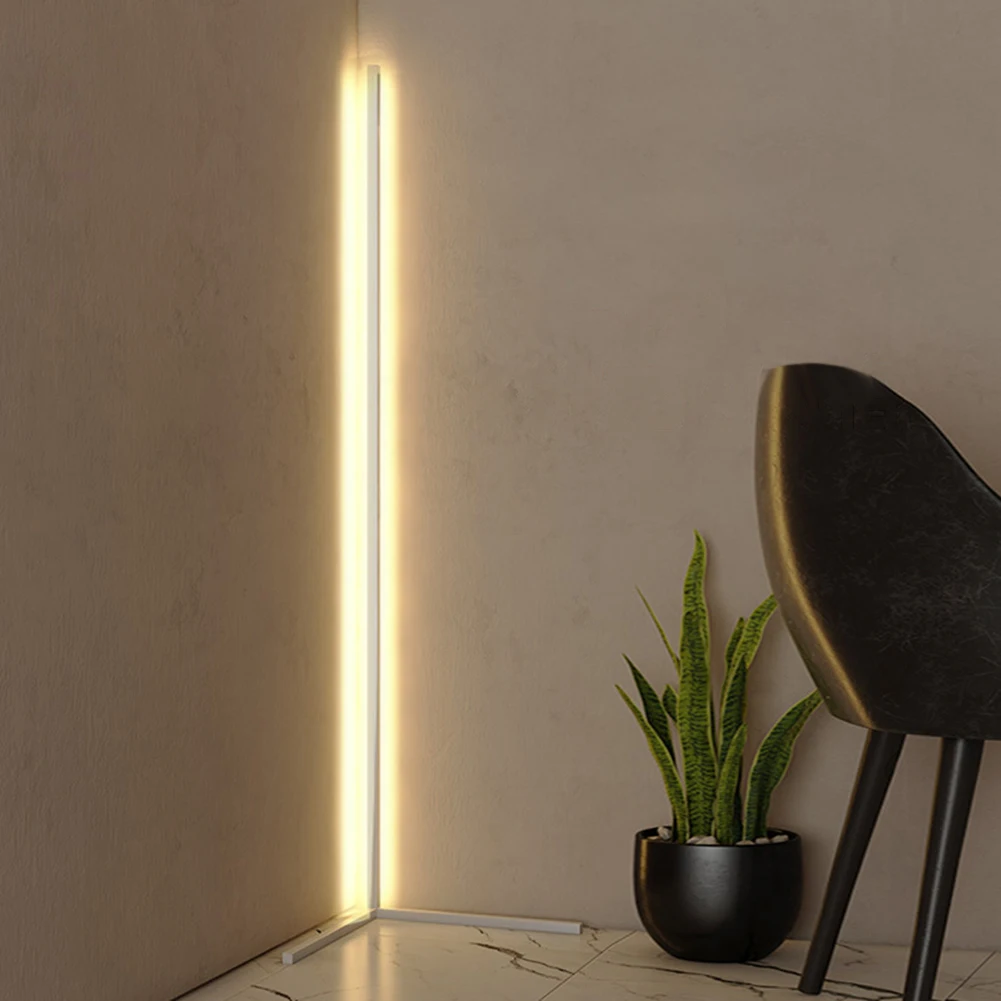
4. Repurposed Pipe Insulation Channel
Materials:
– Foam pipe insulation tube (split type)
– Utility knife
– Double-sided tape
– Spray paint (optional)
Method:
Cut pipe insulation to desired length, slice halfway through to create a channel, optionally paint to match décor, and secure with double-sided tape. Creates an effective floor cord cover for under $5 that can be painted to match flooring.
When considering which arc lamp will work best with your DIY cord management approach, understanding what to look for in an arc floor lamp will help you select models with cord configurations that are easier to conceal.
For more modern spaces, our LED arc floor lamp collection pairs particularly well with contemporary cord management solutions, as these lamps often feature slimmer profiles and streamlined designs.
How to Choose the Right Discreet Wiring Solution
Selecting the optimal cord management approach depends on several key factors specific to your space and lifestyle. Consider these elements when choosing your arc lamp wiring solution:
Decision Factors:
Installation Permanence
– Temporary/Renter Solutions: Adhesive clips, cord covers, strategic furniture placement
– Semi-Permanent: Raceway systems, decorative cord covers, furniture with built-in management
– Permanent: In-wall installations, floor outlet additions, custom furniture modifications
Visual Priority Level
– Completely Invisible: In-wall systems, under-rug flat cords (with appropriate safety measures)
– Minimally Visible: Raceway systems painted to match walls, cord clips along baseboards
– Decorative Approach: Fabric sleeves, designer cord covers that complement décor
Budget Considerations
– Low-Cost ($5-$25): DIY solutions, basic clip systems, simple cord sleeves
– Mid-Range ($25-$75): Quality raceway systems, decorative cord covers, cable management boxes
– Investment ($75+): In-wall systems, custom solutions, designer cord management furniture
Household Factors
– Homes with Pets: Durable cord covers resistant to chewing, elevated cord paths
– Homes with Children: Securely anchored solutions that prevent tripping or pulling
– Accessibility Needs: Solutions that don’t create barriers for mobility devices or present tripping hazards
The most effective approach often combines multiple techniques—perhaps using raceways along walls, decorative covers for visible sections, and a cord management box near the outlet. This layered strategy addresses different visibility challenges throughout the cord’s path.
For rooms that undergo frequent rearrangement, prioritize flexible solutions like removable adhesive clips or cord sleeves that can adapt to new layouts without requiring reinstallation.
Contemporary Arc Floor Lamp, Large Arc Floor Lamp, Oversized Arched Floor Lamp
$460.63 Select options This product has multiple variants. The options may be chosen on the product pageAdjustable Arc Floor Lamp, Bronze Arc Floor Lamp
Price range: $440.95 through $558.52 Select options This product has multiple variants. The options may be chosen on the product pageBrass Arc Floor Lamp, Contemporary Arc Floor Lamp, LED Arc Floor Lamp
Price range: $490.72 through $522.04 Select options This product has multiple variants. The options may be chosen on the product pageChrome Arc Floor Lamp, LED Arc Floor Lamp
Price range: $304.95 through $1,210.40 Select options This product has multiple variants. The options may be chosen on the product pageContemporary Arc Floor Lamp, Large Arc Floor Lamp, Marble Base Arc Floor Lamp
$224.94 Select options This product has multiple variants. The options may be chosen on the product pageContemporary Arc Floor Lamp, Silver Arc Floor Lamp
$459.99 Select options This product has multiple variants. The options may be chosen on the product page
When selecting products, consider future needs as well—a slightly larger raceway system might accommodate additional cords later if you add more lighting or electronics to the area.
Where to Purchase Quality Discreet Wiring Products
Finding the right cord management products involves knowing where to look beyond basic hardware store options. These retail sources offer quality solutions for discreet arc lamp wiring:
Home Improvement Centers
Major chains carry basic raceway systems, cord clips, and in-wall kits in limited colors and styles, primarily focusing on function over aesthetics. These represent good starting points for standard solutions at reasonable prices.
Electronics and Office Supply Retailers
These stores typically offer a wider selection of cord management products, including more specialized options like ultra-flat extension cords and decorative cable sleeves. They often carry higher-quality versions designed for tech-heavy environments.
Home Décor and Organization Stores
Specializing in aesthetically pleasing options, these retailers feature cord management solutions designed to complement interior design styles, including fabric covers, designer boxes, and furniture-quality cord organizers in various finishes.
Online Specialty Retailers
Websites focusing specifically on cord management provide the most comprehensive selection, offering unique solutions like custom-length raceways, designer cord covers in countless materials, and specialized products for specific applications.
When evaluating product quality, look for:
– Sturdy construction with smooth edges and precise fitting components
– UL or ETL safety listings for electrical components
– Strong adhesives from recognized brands like 3M
– Paintable surfaces with fine texture that accepts paint evenly
– Clear warranty terms and reasonable return policies
Expect to invest $15-30 for quality raceway systems, $10-25 for decorative cord covers, and $20-40 for well-made cord management boxes. While budget options exist, investing in higher-quality solutions typically results in better aesthetics and longer product life.
Combining Products for Complete Arc Lamp Transformation
Creating a truly elegant arc lamp installation often requires combining multiple cord management approaches into a comprehensive system. These integrated examples demonstrate how different products work together for optimal results:
Living Room Solution
For an arc lamp illuminating a seating area, combine wall-hugging raceway systems to bring the cord from outlet to floor, then transition to an ultra-flat extension cord beneath an area rug, finishing with decorative cord covers for any exposed sections near the lamp base. This multi-product approach addresses different visibility challenges throughout the cord’s path.
Home Office Integration
When positioning an arc lamp over a desk, use under-desk cord organizers to route wiring alongside other electronics, transition to adhesive cord clips along desk legs, and finish with a cord management box containing both the lamp plug and other office equipment power needs. This creates a clean workspace free of visual distraction.
Open Concept Space
In larger open areas where cords might cross floor spaces, start with strategic furniture placement, add cord clips along furniture backs, transition to floor cord protectors for any exposed sections, and incorporate decorative cord sleeves that complement room accents. This approach balances practicality with aesthetic considerations.
The most successful integrated solutions consider both the technical aspects of cord routing and the visual harmony of your space. Matching materials and finishes between different cord management products creates a cohesive look even when using multiple product types.
Is Completely Invisible Wiring Always Necessary?
While perfect cord concealment often seems like the ideal goal, thoughtful interior design sometimes embraces a more nuanced approach to arc lamp wiring. Consider these alternative perspectives:
Intentional Visibility
Some design philosophies, particularly industrial, mid-century modern, and certain contemporary styles, treat electrical components as honest elements of the space rather than aspects to hide. In these approaches, well-managed visible cords can complement the design language rather than detract from it.
The Middle Ground
Rather than pursuing complete invisibility, consider the concept of “thoughtful visibility”—where cords are managed neatly but not hidden entirely. This approach acknowledges the functionality of the piece while maintaining order and intentionality in how cords are routed and presented.
Material Honesty
Design movements like Bauhaus and certain Scandinavian approaches emphasize honesty in materials and construction. From this perspective, a neatly routed but visible cord honors the lamp’s functionality without pretense. This authenticity can add character to spaces that might otherwise feel too perfect or sterile.
The aesthetic differences between arc lamp finishes extend beyond just the lamp itself to how its components integrate with your overall design approach. A brushed brass lamp might pair beautifully with a fabric cord cover in complementary tones, creating a cohesive design statement rather than trying to hide the cord completely.
For many spaces, the most satisfying approach finds balance between practical cord management and design integrity. This might mean concealing cords along floors and high-traffic areas while allowing thoughtfully routed visible sections where they complement the overall aesthetic.
The ultimate goal should be creating a space that feels intentional and harmonious. Sometimes this means invisible wiring, but other times, it means embracing your arc lamp’s complete form—cords and all—as part of your carefully curated interior design.

